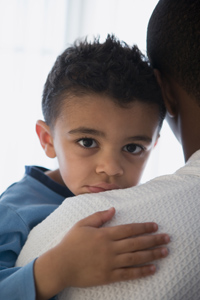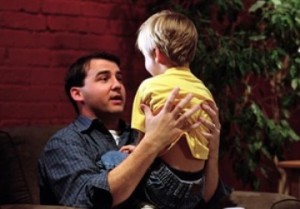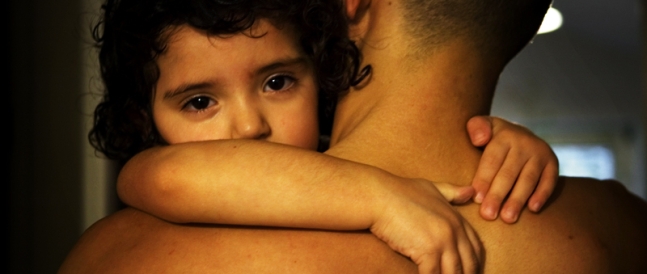Holding the Kid
I want to write today about my experiences in Touch Practice where I have sensed that somehow, instead of holding the adult man I sat down with at the beginning of the hour, I have suddenly accessed a younger, earlier part of that person. I call this “holding the kid.”
 Accessing this state requires a certain period of quiet, relaxed stillness. It typically emerges during more yin styles of practice where there either hasn’t been erotic energy, or else the erotic energy has been immediately engaged, recognized, and discharged/redistributed into the rest of the body. The child doesn’t tend to emerge when there is a lot of adult erotic energy present, but engaging and clearing that energy will often make a path for the younger part of ourselves to manifest.
Accessing this state requires a certain period of quiet, relaxed stillness. It typically emerges during more yin styles of practice where there either hasn’t been erotic energy, or else the erotic energy has been immediately engaged, recognized, and discharged/redistributed into the rest of the body. The child doesn’t tend to emerge when there is a lot of adult erotic energy present, but engaging and clearing that energy will often make a path for the younger part of ourselves to manifest.
Sometimes, I have even had a very, very specific sense of what age has emerged. There are times when I can feel distinctly, “seven years old.” Sometimes it’s more of an age range, like “ten or twelve.” The appearance of the kid is marked by a change in facial affect. Sometimes if we have eye contact with each other, a silly grin or childlike laughter might appear. Sometimes there is a sense of mutual recognition (the emergence of the child in other will often summon my child, so that there’s a sense in which my five year old meets the other five year old.)
I resisted, or never fully realized, the potential within Touch Practice to access earlier states of ourselves simply because I never thought it could or should be possible, but we do this in psychotherapy all the time. People talk to us about, or we talk about, earlier states of ourselves. We still have residue in us, for example, “the way I felt when I was seven” or “the feeling I had when my parents would hold me” or “the way I felt when I was afraid of my Dad hitting me.” Those are not so much feelings we have as adults but feelings we had as children, still very much alive in our bodies.
If we pay attention we can sometimes recognize ways of thinking, or behaving, which are “younger.” Frequently these ways of thinking or behaving were adaptive during one part of our earlier life but later become maladaptive, and we work on rearranging them. That requires some willingness to engage, to “hold” in a thinking sense, the child, who we were as children.
 If we can hold who we were as children psychologically, emotionally, mentally, then it certainly seems reasonable that we can hold who we were (who we are) as children physically. As I’ve made mental space for that concept to exist, and as I’ve become more observant (or even expectant) of that state as it emerges, I’ve learned to work more skillfully and specifically with it, trying to engage the child at whatever age it emerges and create safety and comfort for it.
If we can hold who we were as children psychologically, emotionally, mentally, then it certainly seems reasonable that we can hold who we were (who we are) as children physically. As I’ve made mental space for that concept to exist, and as I’ve become more observant (or even expectant) of that state as it emerges, I’ve learned to work more skillfully and specifically with it, trying to engage the child at whatever age it emerges and create safety and comfort for it.
As I said, creating a sense of restful, safe stillness, and engaging and clearing erotic energy if it exists, seems to be a first step. There are some postures which are more likely than others to emerge the child; for example, “inverted partnered shavasana,” where I lay the person down on top of me, belly to belly, mimics the way a baby would lay on the belly of its mother and will often trigger powerful response. People in that position often cry, and sometimes they fall asleep. In many cases they dream, even though I only allow them to sleep for five or ten minutes or so. I can often tell when someone is dreaming because the body has a tendency to twitch a bit.
With surprising regularity, when I ask people what they were dreaming about (or in the case of people who don’t sleep, if I ask them where their mind went) they tell a story from childhood, from the ages of 4-12. It often corresponds to, or adjusts, my sense of the age of “the kid,” the person who has emerged during the practice.
Much of Touch Practice is intuitive for me and I only understand, later, the reasons why I am led in the direction I’m led. I have always known that creating a good closing—not finishing abruptly or hastily—is a very important part of the ritual. One of the reasons for that, I think, is to give time for this younger self that has emerged to re-integrate back into the grown-up, and to allow the person sufficient time to advance forward, back to their present adult self, before closing the safe space we’ve created.
When practice ends too soon, without sufficient closing ritual, partners tend to experience sadness or grief, or a sense of being abandoned. (This is different from the feeling of “wow, this is wonderful, I could do this all day.” That’s a normal reaction to a pleasant sensation.) I’m talking more about a sense of being abandoned abruptly in the midst of a very vulnerable and tender state. It takes a while to close that state down (roughly speaking, it takes at least ten minutes, and sometimes fifteen or twenty) to get ourselves back into the here and now.
 If this idea intrigues you, notice the ways in which you access your “inner kid” psychologically, emotionally, and in memory. Ask yourself if there’s a way you can access that kid physically, too. (Does he come out when you dance, perhaps? Or if you nap with a blanket in the middle of the afternoon?) I believe that just as we have made safe space for each other to engage “little kid” in our minds, we can do similarly with our bodies.
If this idea intrigues you, notice the ways in which you access your “inner kid” psychologically, emotionally, and in memory. Ask yourself if there’s a way you can access that kid physically, too. (Does he come out when you dance, perhaps? Or if you nap with a blanket in the middle of the afternoon?) I believe that just as we have made safe space for each other to engage “little kid” in our minds, we can do similarly with our bodies.
Have thoughts you’d like to share?
Touch Practice is a sacred practice for me, and part of that is keeping confidences sacred. While a name and e-mail address are required to post a comment, feel free to use just your first name, or a pseudonym if you wish. Your e-mail address will never be seen by or shared with anyone. It is used to prevent spam and inappropriate comments from appearing in the blog. I’d really like to hear from you!














Hi Kevin,
I enjoyed this blog–particularly because I experienced a deep drop into very young child energy as you held me, and spontaneously wept. After that, we experienced deep and loving eye contact. It was a beautiful thing!
I’m a 41 year-old man. Yet I have a teddy bear named “Little Paul” that I hold from time time to time when I am feeling little boy energy–most often when I am scared or feeling vulnerable over a particular event in life. It is a most wonderful and comforting thing. I find I am able to access young child energy quite readily.
Thanks for the blog.
Paul
Wow, Paul, what a great way of “holding” the child. We have so many ways of constructing this, but so many of them are mental. Nothing wrong with using imagination, as we do in psychotherapy, to get a sense of the child we are attempting to hold. But your use of a teddy bear is another great example of ways in which we can physically construct a way to hold ourselves, and others, from the many different eras of our lives. Great to hear from you again.